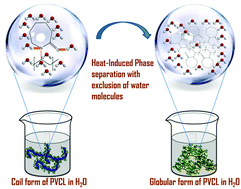The role of osmolytes in the temperature-triggered conformational transition of poly(N-vinylcaprolactam): an experimental and computational study†
Abstract
Biomedical industries are widely exploring the use of thermo-responsive polymers (TRPs) in the advanced development of drug delivery and in many other pharmaceutical applications. There is a great need to investigate the use of less toxic and more (bio-)compatible TRPs employing several additives, which could modify the conformational transition behavior of TRPs in aqueous solution. To move forward in this aspect, we have chosen the less toxic bio-based polymer poly(N-vinylcaprolactam) (PVCL) and three different methylamine-based osmolytes, trimethylamine N-oxide (TMAO), betaine and sarcosine, in order to investigate their particular interactions with the polymer segments in PVCL and therefore the corresponding changes in the thermo-responsive conformational behavior. Several biophysical techniques, UV-visible spectroscopy, fluorescence spectroscopy, dynamic light scattering (DLS) and laser Raman spectroscopy, as well as classical computer simulation methods such as molecular dynamics are employed in the current work. All the studied methylamines are found to favor the hydrophobic collapse of the polymer thus stabilizing the globular state of PVCL. Sarcosine is observed to cause the maximum decrease in lower critical solution temperature (LCST) of PVCL followed by TMAO and then betaine. The differences observed in the LCST values of PVCL in the presence of these molecules can be attributed to the different polymer–osmolyte interactions. The less sterically hindered N atom in the case of sarcosine causes a significant difference in the phase transition temperature values of PVCL compared to betaine and TMAO, where the nitrogen atom is buried by three methyl groups attached to it.



 Please wait while we load your content...
Please wait while we load your content...